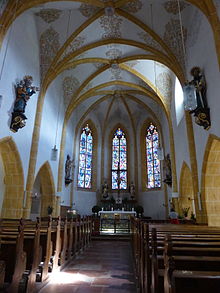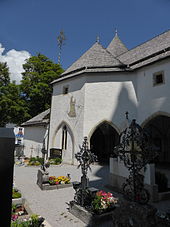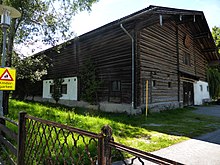Parish church Altenmarkt im Pongau
The Roman Catholic parish church of Our Lady Birth is a church building in the market town of Altenmarkt im Pongau in the province of Salzburg . The ensemble includes the Anna Chapel, the Lourdes Chapel, the Market Chapel, the Tannenkapelle and the Dechanthof and Dechanthofstadel.
Parish history
It is assumed that the oldest church in Altenmarkt is located under today's church and was built in the second half of the 9th century. In 1074, Archbishop Gebhard also donated goods in the Rastat parish , today's Altenmarkt, to furnish the Admont Monastery , which he founded . This name can probably be traced back to a rest stop on Tauernstrasse. The pastor Reicher von Etling can be traced here from 1369 to 1399. He also worked at the court of Archbishop Pilgrim II as chaplain and later as court master and was mentioned by name in the songs of the “ Monk of Salzburg ”. He obtained a number of indulgences ; this suggests that there was lively building activity under him from 1393 onwards.
From 1398 the income of the Altenmarkt parish is used for the table of Archbishop Gregor Schenk von Osterwitz . The parish is led by world priests , only from 1623–1628 Benedictines were active as priests here . The church was probably damaged in the Peasants' Wars (1526) and then changed significantly through repeated additions and renovations.
From 1753 Altenmarkt is a deanery with ten parishes (1857: St. Martin and Wagrain ; 1858: Flachau and Filzmoos , 1859: Radstadt , 1891: Kleinarl , Hüttau , Untertauern and Forstau , 1954: Eben ) and today 14 churches.
From 1867 to 1875 the church was thoroughly restored in line with the neo-Gothic style . During the last interior restoration from 1988 to 1990, the accompanying paintings in the vaults were renewed. The entire exterior was renovated in 1985/1986.
construction
The 42 m long and 22 m wide rectangular church building is divided by buttresses on the outside, which are only missing in the southeastern area. The presbytery is designed as a shallow 3/8 end; to the side of this is a small secondary apse . In 1764 Matthias Pichler's Gothic tower was replaced by the onion tower that exists today .
The seven-bay interior shows an open order, i. H. one yoke of the central nave corresponds to one of the side aisles. All yokes are vaulted with cross ribs . The unusually deep-seated choir arch (between the fourth and fifth yoke ) separates the architecture of the room. The Romanesque forerunner presumably only comprised the masonry of the central nave that reached up to this point, while the remaining three bays and the chancel were added in the last decade of the 14th century. Both side aisles were two yokes shorter in the 16th century; on the north side was the chapel consecrated in 1502 in honor of hll. Andreas , Wolfgang and Ursula , in the south aisle were the Joseph chapel and the sacristy . In 1638 these were extended to the current length. The access to the small crypt under the south aisle, located under today's sacristy, was walled up so that it had to be filled in. The decorative paintings in the vault of the church also date from this period.
Under the dean Sebastian Vorderegger, the church was given a baroque interior in 1762 . At that time, two cumbersome wooden galleries protruded into the central nave. This had dean Thomas Furthner removed from 1867–1875 along with most of the baroque furnishings. He opened the three front bays of the aisles to the nave so that they were the same length as the nave. He had these furnished with the neo-Gothic cross-ribbed vault and the windows with tracery. The gallery, paving, church chairs and the pulpit also come from this redesign.
The main accent of the church is determined by the brightly colored windows that Josef Widmoser from Innsbruck painted in 1954. The middle window shows two angels at the top with the symbols of the lily and the crown, then the birth of Mary , the Annunciation and the Lamentation of Christ . The left window deals with themes from the life of St. Elisabeth of Thuringia ; the right one is dedicated to the diocesan patron Rupertus .
Furnishing
The high altar was redesigned in 1972 based on a design by Clemens Holzmeister . Next to the Baroque cross by Sebastian Eberl are the two assistant figures Johannes and Maria, probably created by the Tyrolean sculptor Josef Martin Lengauer (around 1760). H. Baudisch made the tabernacle .
The marble communion grille comes from the baroque redesign of 1762. The sculptures of St. by Sebastian Eberl also come from this period . Sebastian as well as the hll. Katharina and Barbara . The sheet of the former Joseph altar in the rectory and the portrait of Archbishop Sigismund III. Christoph von Schrattenbach is assigned to his valet Benedikt Werkstätter .
The two side altars (left Mother of God Altar , right Joseph Altar ) from 1902 come from Johann Piger with the collaboration of the cabinet maker Johann Ripper. On the left side altar is a copy of the Altenmarkt Madonna of Mercy, next to it the figures of St. Dominic and Catherine of Siena . The statues on the right side altar show St. Joseph, flanked by Mary's parents, Anna and Joachim .
The Altenmarkt Madonna is a famous example of so-called beautiful Madonnas . The 88 cm high Gothic sculpture was carved out of paving limestone by an unknown Bohemian artist. On August 14, 1393, the Papal Nuncio Ubaldinus da Torres wrote a letter of indulgence on the Vyšehrad in Prague , stating that everyone who prayed in front of the statue received an indulgence. As the Madonna in front of the fir tree , she stood behind the choir head for a long time, but was moved to its own altar in the church in 1638.
The second famous sculpture around 1400 is the Vesper picture . This Pietà , made of artificial stone, is one of the most important examples of a three-handed Pieta : one hand of Mary rests on the crossed hands of the dead Savior, with the second she supports his head under his neck.
In 1976 the confessionals were redesigned according to plans by Clemens Holzmeister. The pulpit was made in 1872 by the Salzburg carpenter Josef Ripper based on a design by Josef Wessicken . The Way of the Cross was built in 1873 by the Zillertal sculptor Matthäus Schiestl the Elder based on a template by J. Führich. Ä. accomplished.
- organ
In 1903 Albert Mauracher extended the organ from 1846 and received a neo-Gothic case. On the occasion of the 900th anniversary of the parish, the second organ loft was demolished in 1974 and a new "anniversary organ" by the Dreher and Reinisch organ builders was placed on the first loft and equipped with a new work.
- Peal
Three of the four bells of the “Salve Regina” peal (c - es - f - g) were cast in 1949 by the Pfundner bell foundry in Vienna; the fourth is from 1920 ( Oberascher bell foundry , Salzburg).
Anna Chapel
In 1395 the pastor Reicher von Etling donated the Anna chapel “on the Karner” in the cemetery next to the parish church. But it wasn't until May 28, 1418 that Bishop Engelmar Chrel von Chiemsee inaugurated it. This Gothic chapel was badly damaged in the peasant wars in 1526, after which it was attached to the church with a two-story connecting corridor.
The chapel has an octagonal floor plan that opens on one side to a narrow sanctuary. The stitch cap vault rests on delicate struts. The originally free-standing building was completed by a painted fish bubble frieze on the outside under the coffin cornice . In 1949 it was transformed into a baptistery. The restoration, which was completed in 1989/90, did not uncover the basement of the church, which was used as an ossuary; a new floor could also be laid and the ribs exposed. Since then, it has served as a funeral hall (the baptismal font previously set up here has been moved to the church).
The figural glass windows with the themes of God the Father , Holy Spirit , Mother of God with Child and Mother Anna with Child were designed in 1955 by Ludwine Wildner-Eltz, who also made glass windows for the Benedictine women's monastery in Nonnberg .
Lourdes Chapel
The former Karner was converted into the Lourdes Chapel in 1875. In 1949, Dean J. Fink had the war memorial in the western vestibule designed, for which Jakob Adlhart copied the Gothic Vespers picture in stone in 1974. On the west wall next to it, the Romanesque portal of the previous church is still visible. The epitaph of the Plaz family is located in the chapel .
Market chapel
The market chapel, newly built in 1991 to the right of the cemetery entrance, houses the restored Marian relief of the former neo-Gothic high altar. The subject of the picture is the birth of Mary, as it is shown on the central window in the church choir that was later created. The relief was made in 1871 by an unknown sculptor from the Salzburg workshop of the church painter Simon Daun. The market chapel, which was originally further to the left, had to be torn down after it was badly damaged when the German troops marched into Austria in 1938.
Fir Chapel
At Dechantshof, south of the church, is the pine chapel, built in 1974, the year of the 900th parish anniversary. With the mural of the “Madonna of the Fir” painted at the same time, the chapel is intended to preserve “the memory and love of Mary our Lady of Altenmarkt”.
Dechantshof
The Dechantshof is a three-storey building with a hipped roof and pilasters . Some of the windows on the first floor have wrought iron grilles. It was rebuilt in 1755. A connecting corridor to the parish church was also installed, which is interrupted by arcades on the ground floor, but is designed throughout and decorated with plastered surfaces on the upper floor.
Dechantshoftenne / Dechantshofscheune
The Dechantshoftenne has been Altenmarkt's second local museum since 1980. The building was erected using a timber frame construction. In the museum there is, among other things, a functioning mill and a device for making roof shingles. A still usable oven for baking bread is also part of the property. A demonstration of flax crumbles is also possible. There are other farm equipment in the barn (including flails, straw shakers, threshing machines, various windmills, sowing machines and seed drills, old wooden plows). Other showpieces are the Altenmarkter Schön- und Schiach perchten .
literature
- The art monuments of Austria. Dehio Salzburg 1986 . Altenmarkt im Pongau, Church of Our Lady Birth, Annakapelle, Lourdeskapelle, Pfarrhof, pp. 10–12.
- Johannes Neuhardt : Altenmarkt im Pongau - Salzburg. Verlag St. Peter - Erzabtei St. Peter (Christian Art Sites Austria, No. 119), 4th revised edition, Salzburg 2006.
Web links
- Guided tour of the parish church of UL Woman Birth in Altenmarkt im Pongau
- Dechantshoftenne on Salzburgwiki
- Dechantshoftenne on salzburg.gv.at
Individual evidence
- ↑ Guided tour of the parish church of UL Ms. Birth in Altenmarkt im Pongau ( Memento of the original from September 18, 2014 in the Internet Archive ) Info: The archive link was automatically inserted and not yet checked. Please check the original and archive link according to the instructions and then remove this notice.
Coordinates: 47 ° 22 ′ 40.2 " N , 13 ° 25 ′ 26.4" E






